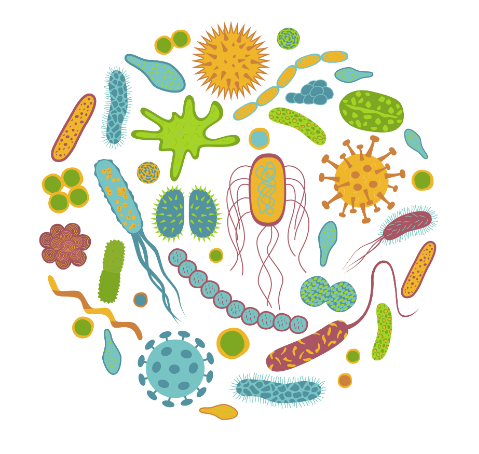Antimicrobial resistance is a serious challenge facing world health, rendering many lifesaving antimicrobials useless. As the world grows more interconnected through travel and migration, the outreach of AMR has intensified, posing a complicated challenge to public health systems globally. Among the largest and most easily accessible reservoirs of both antimicrobial-resistant pathogens and the genes that cause resistance is the human microbiome, the complex ecology of microbes that reside in our body. Understanding the roles of the microbiome and migration in AMR is essential for developing effective strategies for addressing this growing crisis.
The link between the human microbiome and AMR
AMR develops when microbes express or evolve methods that defeat the effects of antimicrobials, making treatment difficult or impossible. While antimicrobial (mis)use is a major driver of resistance, growing evidence suggests that the human microbiome could also contribute to the spread and development of antimicrobial resistance genes, or ARGs.
The gut microbiota serves as an ARG reservoir, containing a wide set of genes that confer resistance. These genes can be passed between different microbial species in the gut by horizontal gene transfer methods such as conjugation, transformation and transduction, which is scary. As a result, antimicrobial-resistant microbes can multiply and spread throughout the gut, potentially leading to infections that are difficult to treat.
Furthermore, antimicrobial exposure can disrupt the delicate balance in the gut microbiome, altering its composition and promoting the growth of antimicrobial-resistant strains. This dysbiosis can perpetuate a cycle of AMR, as resistant microbes gain a competitive advantage over susceptible strains. Studies report that the most abundant resistance genes in the human gut microbiome are those against antibiotics approved for use in livestock.
The impact of migration on the gut microbiome and AMR
Environmental variables, such as contaminated water supplies or unsanitary living circumstances, can add to the spread of resistant strains contributing to the prevalence of ARGs and resistant bacteria in the microbiome. This is influenced by antimicrobial use specific to a geographical setting, as well as diet and socio-political-economic contexts. Hence migration, whether for travel, resettlement or refugee movements, has a significant impact on the gut microbiota and the spread of AMR. Individuals who travel to regions with high antimicrobial usage or poor sanitation may be exposed to a greater diversity of antimicrobial-resistant microbes and ARGs.
Additionally, migration can disrupt the gut microbiome by exposing individuals to new dietary patterns, environmental stressors and infectious agents. Shifts in diet, for example, can alter the composition of the gut microbiome. Additionally, factors such as stress, poor nutrition and inadequate health care access during migration can compromise the immune system and increase susceptibility to infections caused by resistant microbes.
To better understand this, a research study investigated fecal samples from Swedish students before and after their travel to places with a high prevalence of antimicrobial-resistant microbes. Even when no antimicrobials were used during the trip, there was a significant increase in over 300 ARGs in the students’ gut microbiomes after their travel. Notably, genes conferring resistance to common antimicrobials such as sulfonamides, trimethoprim and beta-lactams exhibited significant increases. Shifts in gut microbiome composition, particularly an increase in Proteobacteria following travel, highlighted the gut’s dynamic reactivity to external stimuli such as changes in geographic location, which could facilitate AMR acquisition. Additionally, the study identified colocalization of resistance genes on DNA sequences, suggesting horizontal transfer among gut microbes. This adaptability, coupled with mobile resistance elements, emphasizes the role of the gut microbiome in acquiring and disseminating AMR during migration.
The popularity of seeking medical procedures abroad also raises the risk of transferring highly resistant genes across international borders, facilitated by mobile genetic elements.
Addressing the challenge: Strategies for mitigating AMR in a globalized world
Combating AMR requires a multifaceted approach that addresses both the overuse and misuse of antimicrobials and the transmission of resistant microbes not only among humans but also in agriculture and food-animals. To maintain the effectiveness of antimicrobials, tailored therapies must consider the crucial role the gut microbiota plays in this process.
One approach is to encourage responsible consumption of antimicrobials by means of education, antimicrobial stewardship initiatives and the advancement of alternative therapeutic options like phage therapy and novel antimicrobial compounds. Additionally, in high-risk areas, initiatives to enhance access to clean water, sanitation and hygiene practices can help prevent the environmental contamination that leads to the spread of resistant microbes.
Probiotics, prebiotics and fecal microbiota transplantation are examples of microbiome-based therapies that aim to restore microbial balance and enhance resistance to colonization by antimicrobial-resistant microbes.
In a nutshell, the complex interplay of migration, AMR and the gut microbiota highlights how crucial it is to solve this global health issue. Understanding and preventing the emergence of AMR through focused interventions and innovative treatments will be vital as the world grows more interconnected. By promoting responsible antimicrobial use, improving sanitation practices and harnessing the potential of microbiome-based therapies, we can work towards preserving the effectiveness of antimicrobials and safeguarding public health for generations to come. Collaboration among researchers, health care professionals, policymakers and communities worldwide is essential in the fight to combat AMR effectively.
Link : https://tinyurl.com/mr2e8tt6
References and further reading
Desai AN et al. Antimicrobial Resistance and Human Mobility. Infect Drug Resist. 2022;15:127-133.
